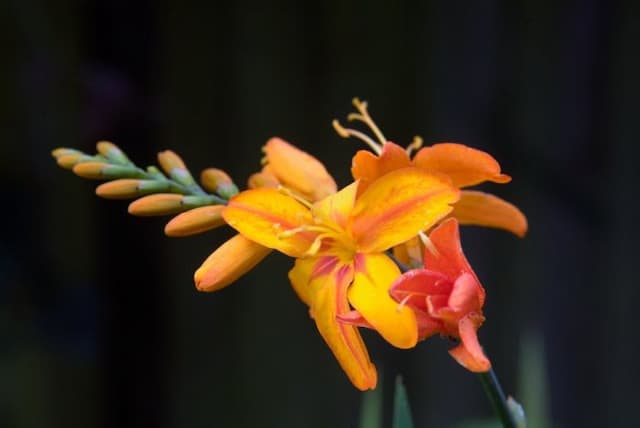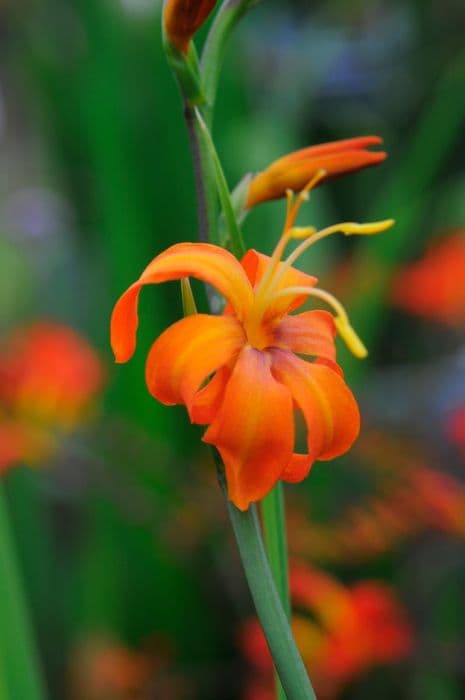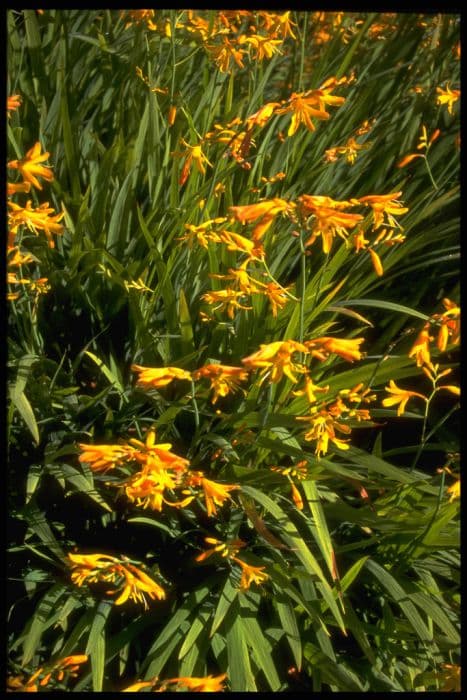White Freesia Freesia laxa var. alba

ABOUT
Freesia laxa var. alba, commonly known as White Freesia, features a clump of narrow, sword-shaped, green leaves that often have a slight arch, giving them a graceful appearance. From this foliage emerges a delicate and slender flowering stem, which supports a loose cluster of funnel-shaped blossoms. The flowers showcase pristine white petals, which can sometimes exhibit a subtle flush of other light colors, adding to their elegance. Each blossom of the White Freesia has a unique, refreshing fragrance that is a delight in any garden or as a cut flower. The flowers are characterized by a zesty, peppery scent that can vary in intensity. The stamens and pistil are usually yellow or pale in color and are centrally placed, subtly accentuating the floral display. The overall look of the White Freesia is one of gentle beauty, with its delightful flowers and aromatic presence adding charm to the late winter to spring landscape. It's a sought-after plant not just for its visual appeal, but also for its contribution to the scents of the season.
About this plant
 Names
NamesFamily
Iridaceae
Synonyms
White Freesia, Cape Freesia
Common names
Anomatheca laxa var. alba, Lapeirousia laxa var. alba.
 Toxicity
ToxicityTo humans
Freesia is generally considered non-toxic to humans. There is little information suggesting that ingesting Freesia has significant adverse effects on human health. However, as with any plant, individual allergies or sensitivities could cause minor symptoms. It is always advisable to avoid ingesting plants that are not commonly recognized as food to prevent any possible digestive discomfort or allergic reactions.
To pets
Freesia is not known to be toxic to pets such as dogs and cats. There is limited information on the plant causing any serious health issues in pets. However, it is still wise to prevent pets from eating ornamental plants as a precaution, and to monitor them for any signs of illness if they do ingest any part of the plant, as individual animals may have different sensitivities or allergies.
 Characteristics
CharacteristicsLife cycle
Perennials
Foliage type
Deciduous
Color of leaves
Green
Flower color
White
Height
1 foot (0.3 meters)
Spread
1 foot (0.3 meters)
Plant type
Bulb
Hardiness zones
9
Native area
South Africa
Benefits
 General Benefits
General Benefits- Ornamental Appeal: Freesia laxa var. alba, commonly known as the white variant of the False Anemone or False Freesia, offers aesthetic beauty with its delicate white blossoms, enriching gardens and homes.
- Attracts Pollinators: Its flowers can attract beneficial insects like bees and butterflies, which are essential for pollination in gardens.
- Fragrance: Freesia laxa var. alba emits a subtle, pleasing scent that can enhance the sensory appeal of any space where it is grown.
- Easy to Grow: It is known for being easy to cultivate, making it a great choice for beginner gardeners or those looking for low-maintenance plants.
- Seasonal Color: It blooms in late spring to early summer, providing seasonal color and interest to garden beds, borders, or containers.
- Cutting Garden Plant: The flowers are suitable for cutting and can create beautiful indoor flower arrangements.
- Companion Planting: The plant can be used in companion planting to help deter certain pests and enhance the growth of other plants.
 Medical Properties
Medical PropertiesThis plant is not used for medical purposes.
 Air-purifying Qualities
Air-purifying QualitiesThis plant is not specifically known for air purifying qualities.
 Other Uses
Other Uses- Perfume Industry: The delightful fragrance of the Freesia can be extracted and used in the formulation of perfumes and scented products.
- Floral Arrangements: Freesia blooms are used in bouquets and floral arrangements for weddings and other special events due to their beauty and fragrance.
- Garden Design: Freesias are often planted for their aesthetic appeal in ornamental gardens, providing splashes of white and an engaging scent.
- Art Inspiration: The striking appearance of Freesia flowers can inspire artists and photographers, serving as a subject in their works.
- Gift Plants: Due to their lovely appearance and scent, Freesias are often given as potted plants for housewarmings or gifts.
- Educational Tool: Botany enthusiasts use Freesias to study bulbous plant growth and reproduction in educational settings.
- Culinary Garnish: While not commonly consumed, Freesia flowers can be used as an edible decoration to embellish desserts and drinks.
- Dye Source: Freesia petals may provide natural tints for fabrics, though this is not a widespread practice.
- Fragrant Potpourri: Dried Freesia flowers can be used in potpourri mixes to freshen the air in homes.
- Symbolism: In the language of flowers, Freesias are often used to convey trust and innocence in various social rituals and communications.
Interesting Facts
 Feng Shui
Feng ShuiThe plant Freesia is not used in Feng Shui practice.
 Zodiac Sign Compitability
Zodiac Sign CompitabilityThe plant Freesia is not used in astrology practice.
 Plant Symbolism
Plant Symbolism- Innocence: Freesia laxa var. alba often symbolizes purity and innocence owing to its delicate and unblemished white petals.
- Trust: The plant is also a symbol of trust, representing faith and confidence in others.
- Friendship: Freesias are commonly given as tokens of friendship and can symbolize the strength and support found in a trusted friend.
- Perseverance: With the plant's ability to bloom in varied conditions, it can symbolize perseverance and the ability to thrive in adversity.
- Thoughtfulness: Giving freesias, including Freesia laxa var. alba, is often associated with being considerate and showing emotional depth.
 Water
WaterFor the Anomatheca laxa, commonly known as False Freesia or White Freesia, the watering should be consistent during its growth season, providing the soil with enough moisture without waterlogging. Generally, watering once per week with about 8-16 ounces of water is sufficient. However, the exact amount can vary depending on temperature and humidity levels. It's crucial to reduce watering once the flowering period is over and the leaves begin to yellow, signifying the plant is entering dormancy.
 Light
LightFalse Freesia thrives in bright, indirect light, making an east or west-facing window ideal. Direct sunlight can scorch the leaves, so filtered light through curtains or blinds is often perfect. Keeping the plant in a spot where it can enjoy morning or late afternoon sun while being protected during the harshest midday rays offers the best lighting conditions.
 Temperature
TemperatureFalse Freesia prefers a mild temperature range, with ideal conditions being between 60 to 70 degrees Fahrenheit. It can tolerate temperatures down to about 50 degrees Fahrenheit, and should not be exposed to temperatures above 75 degrees Fahrenheit for extended periods as it may hinder growth. Protect the plant from drafts and sudden temperature changes for optimal health.
 Pruning
PruningPruning of False Freesia is not extensive and is mostly about removing spent flowers to encourage further blooming. After flowering, cut back the flower stalks but allow the leaves to remain until they yellow and die back naturally, as they are gathering energy for the next growing season. Pruning is best done immediately after blooming has finished.
 Cleaning
CleaningAs needed
 Soil
SoilWhite African Iris thrives in well-draining soil with a mixture of loam, sand, and peat at a pH of approximately 6 to 6.5. A blend of two parts loam, one part sand, and one part peat is ideal. Ensure soil is rich in organic matter to support healthy growth.
 Repotting
RepottingWhite African Iris should be repotted every two to three years to refresh the soil and provide room for growth. Overcrowded bulbs can be divided during repotting.
 Humidity & Misting
Humidity & MistingWhite African Iris prefers moderate humidity but is adaptable to various household humidity levels. Mist occasionally to provide extra humidity if the air is dry.
 Suitable locations
Suitable locationsIndoor
Place White African Iris in bright indirect light indoors, water sparingly.
Outdoor
Plant White African Iris in partial shade with well-draining soil.
Hardiness zone
9-10 USDA
 Life cycle
Life cycleFreesia laxa var. alba, commonly known as White Freesia, begins its life cycle when the corm, an underground storage organ, breaks dormancy and sprouts in response to favorable conditions, typically in the spring. As it grows, strap-shaped leaves emerge from the ground, followed by slender stems that bear lightly scented, trumpet-shaped white flowers, which attract pollinators such as bees for sexual reproduction. After pollination, the flowers develop into small pods containing seeds. Once mature, these seed pods release seeds into the soil to potentially grow new plants. Throughout the growing season, the plant gathers and stores energy in its corm for the next season. The plant then enters a period of dormancy, during which the above-ground parts die back, and it remains dormant until the next appropriate growing season arrives.
 Propogation
PropogationPropogation time
Spring to Summer
Freesia laxa var. alba, commonly known as White Freesia, is most effectively propagated through the division of its corms. The best time for corm division is in late summer or early fall, after the foliage has died back and the plant has entered dormancy. To propagate, gently dig up the corms and separate them from the main clump, ensuring that each section has at least one growth point. Corms should then be replanted immediately at a depth of approximately 2 inches (5 cm), spaced about 3 inches (7.6 cm) apart in well-draining soil. Ensure the area where they are planted gets ample sunlight and maintain consistent moisture until the corms are established. This method of vegetative propagation is not only popular due to its simplicity but also because it helps maintain the genetic consistency of the plants.
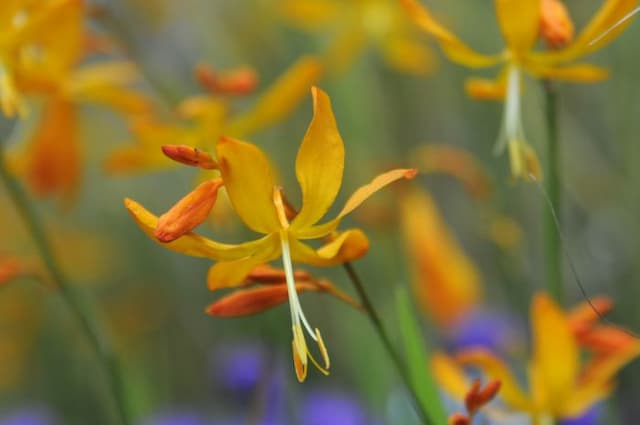
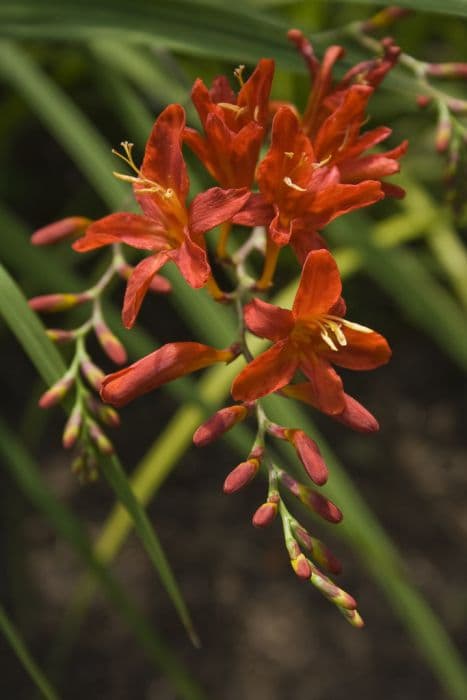
![Montbretia [Bright Eyes]](/_next/image?url=https%3A%2F%2Fplants-admin.emdemapps.com%2Fimages%2Fplants%2F%2Fimages%2F604b5f4a483b6.png&w=640&q=75)
